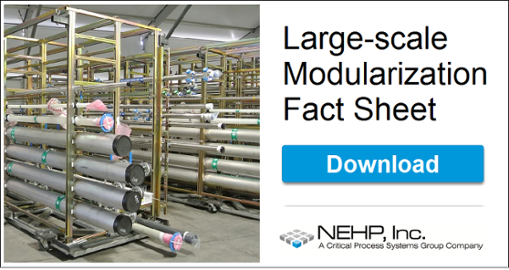Benefits of Fabrication Grade MEP Coordination Models
The construction industry is under constant pressure to overcome schedule, budget, labor and productivity risk factors. This enduring struggle has given rise to many methods and technologies geared toward eliminating inefficient and/or conflict-prone processes.
Fabrication grade MEP coordination models represent an evolution to that end. Such models provide detailed layout and spatial information related to the mechanical, electrical, plumbing (MEP), process piping and data systems within an architectural design of a facility. Their primary purpose is to illustrate and identify any potential conflicts between the various equipment layouts and architectural elements that must be squeezed into a project envelope.
/Seaport%20-%20Pumps.jpg?width=1860&name=Seaport%20-%20Pumps.jpg)
While building coordination can be performed through either 2D or 3D drawings, 3D drawings are preferred for their level of detail in modeling a clash-free design. With the use of different visualization techniques (line weights, color coding, etc.), LOD 400 model content is able to highlight relevant engineering equipment at different elevations, and therefore expose complex 3-dimensional clash-points anywhere in the design.
Given the highly detailed nature of this work, building coordination takes considerable time and effort. However, as modern facilities grow in complexity, MEP coordination models compensate for the added time and effort by enabling highly dependable designs, build schedules and budget projections.
Fabrication Grade Coordination Models Facilitate Alignment and Help Control Costs
Typically during the coordination process, architects and engineers produce schematics of the MEP systems, then a specialized contractor compiles these drawings and incorporates the needs of the architect, engineer, and the facility owner. Before construction can begin however, a coordination meeting takes place to review and identify any conflicts within the design, and to make any final alterations. While this process does add an expense to the design phase, it rids any uncertainty during construction.
In non-coordinated designs, structural and MEP clashes will be discovered during the build process, meaning extra time and money will need to be spent altering the design in the construction phase. This incurs greater cost due to the impact it has on related or interdependent construction sequences along the way. Additionally, such conflicts can create costly problems and diminished performance in the MEP systems due to forced alterations in the design.
Allocating extra effort and attention to the coordination process has been shown to reduce overall costs of the building by decreasing construction disruption[1]. Not only does this save building owners time and money, but it also demonstrates an AE firm's level of forethought and modernization.
Finally, as an added bonus, LOD 400 model content is equally beneficial for MEP and HVAC system installers. A well thought out, visualized plan for the positioning of each of the system's components makes for a quicker, more straightforward installation by these sub-contractors. Henceforth, systems will be installed properly the first time and on schedule.
To learn more about construction productivity improvement with utility dense systems and facilities, please feel free to access the large-scale modularization fact sheet from our trusted partner, NEHP, below.
Sources:
[1] Riley, David and Michael Horman (n.d.), “The Effects of Design Coordination on Project Uncertainty.”

